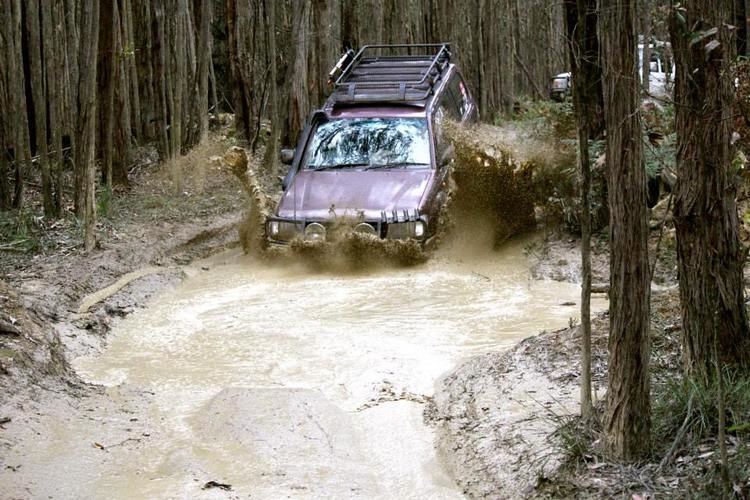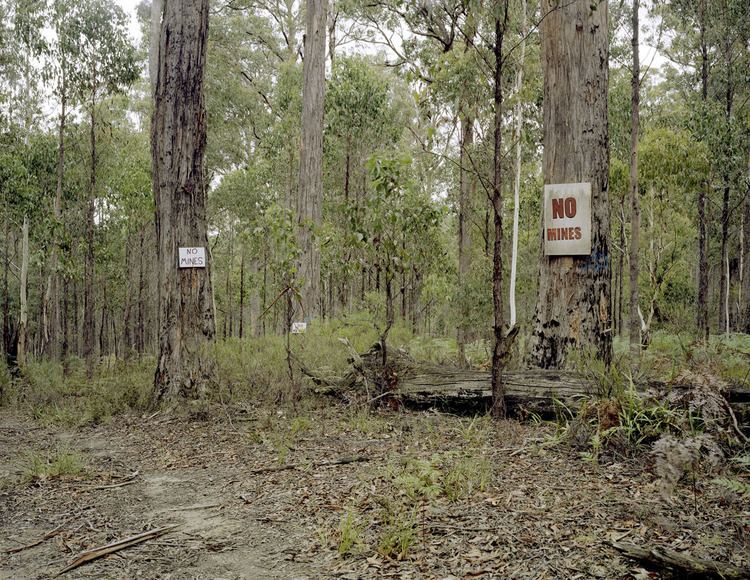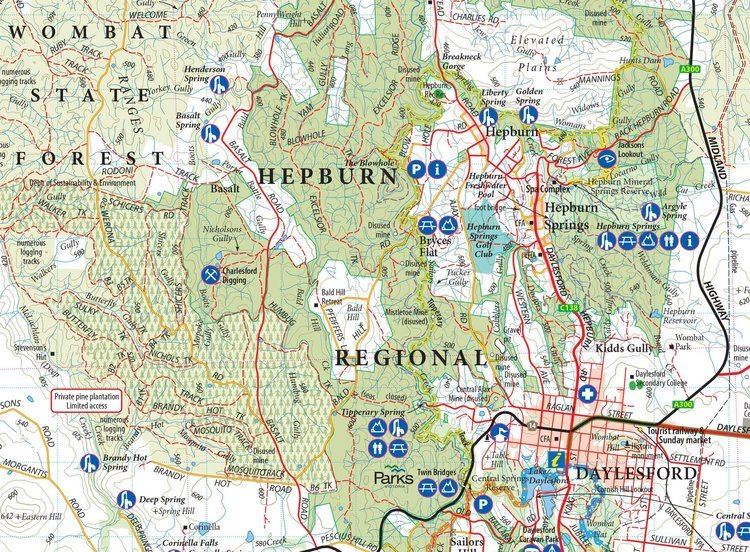Area 700 km² | Established 1871 | |
 | ||
Managing authorities Similar Great Dividing Trail, Castlemaine Diggings National, Wombat Hill Botanic Gardens, Enfield State Park, Convent Gallery | ||
Wombat state forest 27 8 2016
The Wombat State Forest (locally: Bullarook) is located 50 kilometres (31 mi) west of Melbourne, Victoria, Australia, between Woodend and Daylesford, at the Great Dividing Range. The forest is approximately 70,000 hectares (170,000 acres) in size and sits upon Ordovician or Cenozoic sediments. The Bullarook Wombat State Forest was proclaimed in 1871.
Contents
- Wombat state forest 27 8 2016
- Loves it 4x4 takes on the wombat state forest 2016
- Etymology
- History
- Geography
- Fauna fungi and flora
- Ecological classification
- Community management
- Tourism
- References

The only initiative in Australia to introduce community forestry, within the internationally understood context, is in the Wombat State Forest. It is managed by the Department of Sustainability and Environment. The management plan covers several areas such as firewood and other products; protection of water supplies, conservation of biodiversity, and conservation of landscape. Other areas of importance include cultural heritage, research, education, tourism, recreation, mineral exploration, mining, and grazing.

Loves it 4x4 takes on the wombat state forest 2016
Etymology
The forest is probably named after the Wombat township (now Daylesford) where it sits geographically.
History

The Dja Dja Wurrung peoples inhabited the area that is now state forest land. In its early days prior to European settlement, it probably extended to a much larger area than it does today.

Much of the forest lands was logged out during the gold rush era of the mid-1800s. During this time, the forest was intensively logged, the wood products used as tunnel supports, sleepers for tramways, lining of mining shafts, to fire mine boilers, piles for piers and docks, electric poles, heavy construction timbers and fuel wood. It was only in 1860 that the 1860 Land Act (Section 80) was created, prohibiting the slashing and subtraction of trees. Eleven years later, in 1871, the Wombat State Forest was established.

By 1884, there were 36 saw mills in operation in the Wombat and Bullarook Forests, the wood having been shipped to Melbourne, Sandhurst, and Ballarat. There was little or no reproduction and the young trees were burned. This eventually resulted in what is termed as "ruined forest", the forest remaining in that state for several decades without any agricultural operations allowed.

As the forest was almost abandoned after the gold rush period, a regeneration process emerged. This activity plateaued in the 1960s when shelter wood logging came into effect for silviculture, resulting in more deforestation. However, in the 1970s and 80s, the area was designated as the "Midlands Forest Management Area" which included the planting of pine trees for commercial exploitation.
When in 2001, the local community published its own findings about the forest's sustainable management, it became an example of community involvement in a state-run management plan. In 2010, community groups fears were raised that logging could resume in the forest because the State Government allocated logging licenses in western Victoria.
Geography
The Great Dividing Range straddles the Wombat State Forest. The forest extends along both sides of the Dividing Range, from Creswick to Mount Macedon. There are about 400 volcanoes in a stretch that extends from Kilmore in the north to Mt Gambier in South Australia. Mount Babbington, Mount Wilson and Blue Mount are extinct volcanoes within the forest.
The prevalent geological make up is of Ordovician or Cenozoic sediments. The rock types are of volcanic origin, dated to the Palaeozoic era. Quaternary basalts, all of volcanic origin, constituted the forested land to the west of the Wombat State Forest. These lands were converted to agricultural zone due to the suitability to grow crops under abundant rainfall conditions. However, Ordovician or sedimentary soils, due to its poor soil conditions for farming, have remained undisturbed. The geological evolution belongs to the Quaternary period of the Cainozoic Era which has emerged from an "ash dominated rainforest to dry sclerophyll forest". The preceding geological evolutions in the order of their ascending order of dating are: the Palaeozoic Era, the Precambrian Era, and the Mesozoic Era.
The Wombat State Forest contains the headwaters of the Lerderderg, Campaspe and Loddon rivers. A notable feature in the forest is the extent of mineral springs which is said to account for 80% of Australia’s mineral springs. The mineral waters are rich in calcium, silica, magnesium, iron and sulphur. The volcanic activity of the region has supplemented the creation of mineral water- carbon dioxide mix that is seen in the form of bubbles emerging from the springs.
Fauna, fungi and flora
The forest's faunal era emerged during the Precambrian Era, initially with cyanobacteria (blue green algae) and soft bodied marine organisms. These were followed by the Cambrian Period with Metazoans dominating the sea, followed by the earliest vertebrates of the Ordovician Period, the Carboniferous/Permian Period of insects, Triassic Period of early small dinosaurs, Jurassic Period of dinosaurs, Cretaceous Period, Palaeocene Period of mammals, Oligocene Period of early primates, Miocene Period of possums, kangaroos, koalas, bats, snakes, crocodiles and birds, and finally the Holocene Period of human civilization.
The native fauna consists of marsupials and monotremes, reptiles, amphibians, bats and birds. The greater glider (Petauroides volans) is the largest possum found in this forest. It has furry hair with the colour varying from grey to cream and with a pale underside. It has a large snout and large ears. Its range is in the western part of the Wombat State Forest. Several state-listed threatened bird species occur in the forest including the great egret, intermediate egret, grey goshawk, Australian masked owl, powerful owl and square-tailed kite. Additionally, the forest is the western extent of the range of the red-browed treecreeper and olive whistler.
Fungi comprise the next biggest kingdom after Animalia and the Wombat Forest is a rich storehouse of fungi. Hundreds of fungal species have been documented across the forest's diverse habitats. Fungi play a vital ecological role through their mutually beneficial symbioses with the great majority of plants as well as with numerous animal species. They are also important recyclers of organic matter, breaking down complex molecules, returning organic matter to the soil and making nutrients available to plants. To put it simply, without fungi, the forest wouldn't exist.
The major morphological fungal groups such as agarics (fungi that typically have an umbrella shape and gills beneath the cap, commonly known as mushrooms), puffballs, coral fungi, polypores, disc fungi, clubs and lichenised fungi exist in the forest. Numerous species of myxomycetes (slime moulds) have also been recorded."
Parasitic fungi also occur in the forest. While some parasitic fungi can become problematic such as Armillaria luteobubalina, a fungus that causes forest dieback, parasitic fungi also play an important ecological role in creating habitats for many animals, such as the great number of invertebrates, mammals, birds and reptiles that rely on tree hollows.
Fungi have been found in every habitat type in the Wombat Forest. Like animals and plants, fungi have preferences for different habitats; some grow only on fallen wood, others on animal faeces, some at the base of particular tree species, in moss beds or forest floor humus, some occur only after fires, and others are found in dry bare earth. Many fungus species fruit between late summer and early winter, depending on temperature, rainfall and various other environmental factors such as soil chemistry. Fire also plays a role in triggering the fruiting of some fungi. Furthermore, fungi provide an important food source for many of the Wombat Forest's animals including mammals, birds, reptiles and invertebrates.
Fungi are still barely recognised as a vital part of Australia's biodiversity. Although Australia has national, state and territory biodiversity conservation strategies and has ratified international conventions, most Australian conservation legislation overlooks fungi. While several countries have comprehensively mapped and RED-listed thousands of fungal species, only a handful of Australian fungi have been formally protected and only at a state level.
Groups such as Wombat Forestcare, Fungimap and various field naturalist clubs are making huge efforts and progress toward lifting the profile of fungi through acquiring knowledge of their diversity and distribution and contributing to fungal conservation.
During the forest's geological evolutionary process, flora initially emerged in oceans 630 million years ago. This was followed by plants emerging in late Ordovician Period and early Silurian Period. They were succeeded by the Jurassic Period of Ancient Flora (including Gondwana Cretaceous Period and West Gondwana) as is evidenced in Australia with the emergence of conifers. The Palaeocene Period of tree species was succeeded by the Eocene Period of grasses which was followed by rain forests. With the Miocene Period, eucalypt forests emerged, followed by the Pliocene Period of cooler climate with some northern tropical species emerging, and finally followed by the Quaternary Period of dry climate with dry vegetation.
The native flora broadly consist of small medium and tall trees; shrubs of varying sizes; climbers; native herbs/forbs, grasses; rushes, sedges and aquatics; lilies, ferns and orchids. The open forest is dominated by a number of eucalypt species including messmate (Eucalyptus obliqua), broad-leaf peppermint (E. dives), narrow-leaf peppermint (E. radiata), manna gum (E. viminalis) and candlebark (E. rubida). Swamp gum (Eucalyptus ovata) and Yarra gum (E. yarraensis) are also present in the forest.
Rare or threatened plant species of record include wiry bossiaea (Bossiaea cordigera), matted flax-lily (Dianella amoena), Brooker’s gum (Eucalyptus brookeriana), Fryerstown grevillea (Grevillea obtecta), creeping grevillea (G. repens), hairy beard-heath (Leucopogon microphyllus var. pilibundus), satinwood (Nematolepis squamea subsp. squamea), small sickle greenhood (Pterostylis lustra), scented bush-pea (Pultenaea graveolens) as well as two endemic species Wombat leafless bossiaea (Bossiaea vombata) and Wombat bush-pea (Pultenaea reflexifolia).
Ecological classification
Ecological classification of native vegetation in the Wombat Forest has been carried out, with 16 different Ecological Vegetation Classes (EVCs) being identified. The widely varying vegetation is a reflection of ecological diversity of the forest "in geology, soil type, aspect, climate, altitude and position in the landscape." Under the EVC classification system followed in Victoria, the criteria adopted covers "depletion (what is left since European settlement), degradation, current threats and rarity". Shrubby Foothill Forest which is found on both sides of the Great Divide accounts for 57.66% under the least concern category while the Swampy Riparian Woodland and Streambank Shrubland are under the endangered category.
Community management
Wombat Forest Community Forest Management (CFM) is a cooperative process in which the community of Wombat has been entrusted the responsibility to manage the Wombat State Forest. The management initiative started in 2002 with inputs from experts in forest management and other disciplines. The slogan "Our Forests Our Future" started the reform process. The University of Melbourne facilitated by providing the consultancy inputs in preparing a review report on collaborative forest management and community participation in Australia. This report was titled "Collaborative Forest Management – A Review".
The Wombat Forest Community Biodiversity Research Project was developed to determine what kinds of animals live in the Wombat Forest, and what sort of habitats do they prefer. The project is a collaboration of the Biodiversity Working Group and the Arthur Rylah Institute for Environmental Research.
Tourism
Lyonville Mineral Springs, Garden of St Erth, the Lerderderg Heritage River Walk, and Nolans Creek Picnic Area are among the tourist attractions within the state forest. Other historic places of interest include the Andersons Mill, Balt Camp, Pioneer Sawmill, and Yankee Mine. Train buffs can travel by vintage diesel rail through the forest.
